Wondering what challenges of CRM you might face while implementing it? You’re in the right place.
This article will discuss the most common challenges of CRM and their solutions.
CRM is the heart of many organizations’ sales ecosystems. These CRM systems play a crucial role in facilitating the collaboration between marketing, sales, and customer service.
But implementing CRM for the first time can be tricky for many organizations. Oftentimes, neither the sales teams nor the management have experience restructuring the sales process and infusing it with technology to achieve higher productivity and operational efficiency.
There are a few common challenges that cause many CRM projects to fail rather than achieve their desired goals regarding ROI.
So without further ado, let’s discuss the challenges of CRM one by one.
Solving the Top 11 Challenges of CRM
Following are the most common challenges of CRM that businesses face.
1. Building a Clear CRM Implementation Strategy
As with any other technology implementation, having a clear and organized strategy for successful CRM adoption is inevitable for businesses, making it one of the top CRM challenges for businesses.
Since you’ll be completely revamping your customer relationship management approach, there is no room here for slip-ups. This is precisely what makes it one of the biggest challenges of CRM implementation.
However, past studies have found that nearly half of CRM implementations suffer in terms of unclear strategy, misaligned goals, and differing objectives among internal stakeholders.
That’s why it’s necessary for you, as a business, to formulate a CRM strategy before moving forward with selecting the right tool to overcome this challenge.
How can you solve this challenge of CRM?
The implementation process will include brainstorming on the CRM’s integration plan with existing customer relationship management techniques and sales and marketing tools.
To achieve a successful CRM implementation, follow this seamless implementation roadmap:
- Set realistic and measurable business objectives.
- Take suggestions and feedback from internal stakeholders, including sales, marketing, and customer support teams, to improve user adoption.
- Find out whether you need a custom-built or off-the-shelf CRM tool.
- Find the right CRM platform, vendor, or tool for your business.
- Select a CRM team among department heads and champions.
- Forecast the cost and benefits.
- Integrate and migrate data.
- Train your sales team and test the new CRM system.
- Learn and improve to ensure CRM success.
Don’t forget that the new CRM system will overhaul your current processes, so your implementation strategy should integrate this new system with your current infrastructure and workflow, which could be a challenge if not done well.
The right implementation strategy will minimize the time required for your routines to get comfortable with the software.
And this brings us to another challenge related to CRM adoption.
2. Implementing Change Across Departments
The most demanding challenges in CRM implementation aren’t related to the technological aspect; instead, they are related to people.
Even if you don’t have expertise in CRM technologies, the right CRM solution provider can help you with that.
But convincing your people to start using a new system for customer relationship management can be challenging for many organizations, especially where non-tech-savvy workers are in the majority.
The transition can be relatively easy in organizations where the workforce is young. But with older staff members and sales experts, the migration from the traditional approach of customer management to CRM will be challenging.
This challenge can lead to CRM implementation fails and create an unfavorable work environment. Effective communication is key to overcoming this hurdle.
If you are unable to bring in the change across departments and implement a CRM, the consequence will be workers who feel they now have too much to do and track. Additionally, executives will feel their expectations aren’t being met because no one utilizes the revolutionary tech they’ve implemented.
You May Also Like:
How can you solve this challenge of CRM?
There’s a reason why people feel reluctant or struggle with adopting technology into their conventional customer relationship management infrastructure. And that reason is usually that the company doesn’t have a pre-defined strategy for implementing a CRM.
And this brings a huge challenge to technology adoption.
A culture of learning and digital innovation is essential to the need to unlearn existing practices and adopt something better. And this culture should be encouraged and enforced by top management.
Learning new methods requires people to dedicate time and focus so they can change the way they work. If you don’t create a work culture that incentivizes and inspires, people won’t make the effort, and the technology will remain a challenge.
To solve this challenge, you need to create awareness of CRM’s usefulness. Conduct proper training programs that give hands-on CRM experience to your people.
Here’s how you can mitigate the CRM adoption challenge:
- Convey the benefits of CRM tools, like how they will improve workers’ productivity and help them obtain and serve more customers.
- Gather feedback from your workers before implementing your CRM system. Understand what the most crucial CRM features for them are to improve user adoption.
- Make them a part of your CRM journey.
- Appoint assistance that will guide them through CRM adoption.
- Make CRM use mandatory for everyone in the customer relations ecosystem. It should be the only repository for your organization.
- Make CRM adoption fun by introducing reward programs.
You will likely notice a lack of productivity for a week or so. But once your sales, marketing, and customer service teams get the hang of it, they will be engaged with the training programs.
This will ensure that the majority of your staff is well-versed in CRM technology and its best practices.
And this brings us to the next challenge of CRM implementation.
3. Managing the Time and Cost Associated with CRM Implementation
Every technological implementation comes with costs in terms of money and time. Many organizations fail to predict the outcomes of their CRM implementation and are therefore reluctant to invest in the costs associated with it.
From CRM vendor selection to implementation, training, and business dependency, the cost of custom CRM is enormous, which can be a challenge for SMBs. Typically, CRM solutions like Salesforce can cost around $250–$7,500 for a 10-15-user team monthly.
Considering the cost, it can be a challenge for decision-makers to invest such a significant amount. This is why careful planning is essential for successful implementation.
The following are the factors associated with the total cost of CRM.
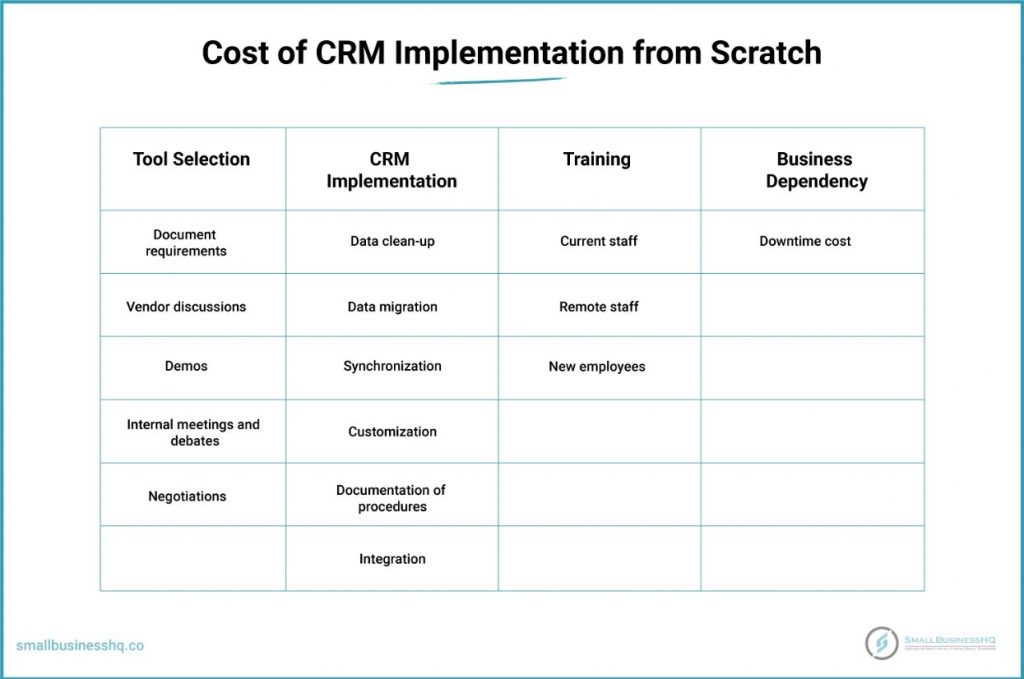
For small to mid-scale businesses, the best approach for a seamless CRM implementation is to go with off-the-shelf CRM solutions.
Currently, companies can pick among several powerful CRM tools like Zoho and HubSpot. These CRM tools are easy and quick to implement, and their cost is meager compared to custom CRM system implementation.
This can solve the cost-related challenge of CRM adoption.
However, selecting the right CRM tool for your company isn’t an easy task. Before picking an off-the-shelf CRM tool vendor, you need to think about several factors.
Answer these questions for your business:
- Can it integrate with your existing marketing technology infrastructure?
- Does it have an email integration feature for your email service provider?
- Does it offer document management features that enable team collaboration?
- Does it allow you to create and send quotes or proposals to customers?
- How does it manage the customer pipeline?
- Does it offer workflow automation for repetitive tasks?
- Does its contact management functionality make sense to you?
- Does it offer an interaction tracking feature that allows all the necessary parties to collaborate?
- Can it illustrate your customer funnel and drive valuable insights?
- Do you need advanced analytics functionality? If yes, how does your CRM cater to your analytics needs?
- Does the CRM tool offer sales forecasting and projection features based on historical data and current trends?
Every business is different; hence, their CRM needs will usually be different, too. While selecting a powerful tool for your specific CRM needs, think about the goals behind CRM implementation and try to figure out your needs.
Most importantly, when selecting either a custom or an off-the-shelf CRM tool, make sure that you calculate its return on investment.
And this brings us to the next challenge of CRM adoption.
You May Also Like:
4. Scaling CRM Solutions
The cost to implement CRM tools largely varies by the number of users and the scale of the scale of the customer database.
Whether you’re a startup, mid-scale enterprise, or Fortune 500 company, there is always room for growth. Considering the fact that your business always aims for growth, your CRM needs will grow as well.
Many companies face the challenge of CRM scalability when it comes to implementation at an enterprise scale. The reason behind this is that when most businesses implement a CRM solution, the number of users is narrow. But as they grow, they need more sales and marketing people to utilize the CRM.
And this is where the challenge of CRM scalability lies.
With more users, the operational cost of off-the-shelf CRM tools increases. Even if you’ve implemented a custom-built CRM solution that is affordable only for large-scale companies, there will be a need for new features.
How can you solve this challenge of CRM?
Whatever the case, you need to project your future needs when creating a CRM implementation strategy.
If you’re going with an off-the-shelf CRM solution, make sure that it has all the necessary features that you’ll need in the future; otherwise, it’ll be challenging to scale your business.
If you’re building a CRM solution in-house, for example, make sure you choose the right set of technologies that can facilitate the advanced features you’ll require in the future.
The next challenge in CRM adoption comes from the top.
5. Convincing Top-Level Management
Even if you have motivated your sales, marketing, and customer relations teams, one possible internal stakeholder challenge can arise from the top.
Convincing the top management is among the most common challenges of CRM implementation.
Sales and marketing managers may feel sure that their team can benefit from shifting to a fully automated CRM system. Still, the decision-makers and the C-level executives might think otherwise.
Getting their approval can be a challenge, especially when the cost of CRM implementation is high and user adoption is not favorable.
How can you solve this challenge of CRM?
In order to get approval from your top-level management, you need to address their concerns about the technology pricing and disruptions leading to undesirable downtime.
Therefore, you need to communicate to them concrete ROI forecasts and the realistic benefits of adopting the CRM system.
Consider giving the answer to the following questions to mitigate this challenge of CRM adoption:
- What will the impact of using CRM be on the company’s overall performance?
- Which of your competitors have been using a CRM tool, and how has it benefited them?
- How will the CRM tool leverage customer data to generate insights for your business?
- Can you illustrate how CRM will improve your relationship with customers?
- What percentage of customer retention rate increase do you expect after implementing the CRM?
- By what percentage will customer acquisition increase?
In other words, make your top management aware of the tangible value CRM implementation will add to your sales, marketing, and customer relations teams.
This should help you get over this challenge of CRM adoption.
More often than not, top-level management is just as concerned as you are with handling customer data. And this brings us to the next challenge of CRM.
You May Also Like:
6. Ensuring Data Security
When it comes to marketing and sales, customer data is the most valuable asset. And when you’re using a cloud-based solution to handle your customer information, data security should be your foremost concern.
The challenge here is to make sure that all data is handled with the utmost care.
If you don’t have a CRM implemented currently, you are probably managing the data on a local server; moving it to the cloud can be an alarming idea for your top management.
While migrating your CRM data from the local server to the cloud, you need to ensure that the system integrators use the best practices to safeguard your data. This is crucial for maintaining data integrity and ensuring the system’s effectiveness.
For this, be sure to partner with someone you can trust or hire dedicated resources for the migration process.
How can you solve this challenge of CRM?
CRM implementation can be done via two approaches: custom-built and off-the-shelf. Because of this, data security will be handled differently for each type.
While building your own CRM, you need to make sure that the software architecture works well with your existing customer data format. If you have outsourced the development of your CRM, make sure the team is well-versed in the best data handling approaches.
This should alleviate the data security challenge in terms of custom CRM development.
And if you are migrating your customer data to an off-the-shelf CRM tool, make sure you pick a tool that facilitates easy and intuitive data importing.
Since data integrity is also a concern for businesses, your CRM tool should have an SSL certificate. Without SSL, your data is in danger, as any third party can find it, potentially leading to incomplete data issues.
You May Also Like:
7. Relearning the Software Programs
Although we’ve already discussed this challenge partially in CRM adoption, this is worth mentioning separately.
Even if you have convinced your team to try to get along with the CRM system, there’s a possibility that they just can’t, especially if you have long-time workers on your teams who have been doing things a particular way for many years.
Old habits die hard, and this is the reason why you need to help your employees understand the difficulty of unlearning their favorite practices and shifting to brand new CRM systems.
How can you solve this challenge of CRM?
Although unlearning old practices can be a challenge for your employees, you can alleviate their pain by providing the required time for proper training and practice.
Create a task list for your employees where they are needed to perform specific actions to learn and practice with your CRM tool. This can help encourage adoption and improve the system’s effectiveness.
Most importantly, assign monitoring and validation duties to someone within the team so that nothing goes wrong when your employees feed in data to a system they’re not familiar with.
This is crucial because your employees will make CRM mistakes while learning, and you don’t want your CRM data to be corrupted.
8. Future-Proofing the Technology Implementation
We all know that the technologies we use currently might be obsolete within the next 5 to 10 years.
This is why making sure that you invest in the right CRM system is essential for your business growth strategy.
How can you solve this challenge of CRM?
Find out which technologies are likely to still be around in the future and are easy to migrate from. This foresight can help modern businesses stay ahead of the curve.
Be sure to also keep your finger on the pulse of the latest trends and technologies related to CRM tools.
As per the present technology landscape, the future of CRM systems seems to be bright. For now, it seems they’ll continue to report sales insights far into the future.
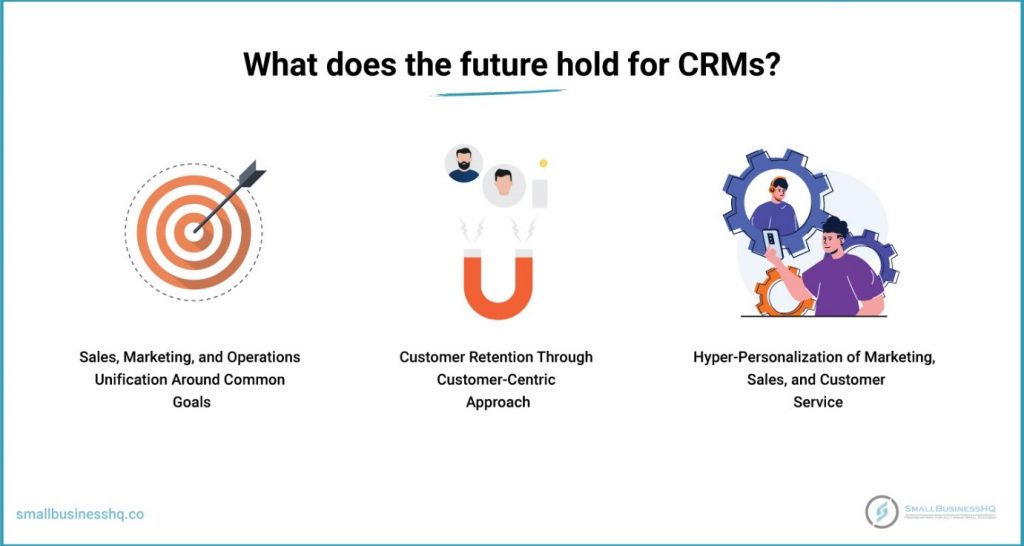
Taschek also adds that marketing will primarily be responsible for getting customers’ attention and communicating the brand message, whereas salespeople will need to become subject matter experts. Customer service will bring people together by providing communities that capture information.
Moreover, the approach to customer retention will also change as the cost of switching from one CRM solution provider to another becomes very low for customers.
In order to retain customers, businesses will have to do much more than maintain conventional loyalty programs. They need to communicate to their customers that the company is all about them.
Mass personalization through relevant data, therefore, will be the norm for marketing automation.
Although the hyper-personalization of marketing communication and sales is somewhat limited in today’s landscape, it’s a very real possibility in the near future. This can be feasible through the mining of an extensive amount of ambient data, which will be collected via sales enablement.
The point is to find out the future scope of CRM tools and create or adopt a system accordingly to solve this challenge of CRM adoption.
You May Also Like:
9. Lack of Clarity in Terms of Scope
One of the most common challenges of CRM is the absence of clarity in terms of scope and objectives behind the implementation.
This challenge of CRM implementation results in several issues, including budget overruns and ROI delays.
The challenge is that neither mid-level managers nor top-level executives spend adequate time and resources determining the requirements for their chosen CRM.
Even if you determine the features and functionalities required of a CRM, you might fail to anticipate the quantity and quality of data entry needed.
How can you solve this challenge of CRM?
Finding the exact requirements and scope of the CRM project isn’t a one-person task. You need to engage people from several departments and levels to anticipate requirements for the CRM implementation.
To solve this challenge of CRM, it is always safer to adopt an agile project development approach so that you can improve during its implementation and achieve a more successful CRM implementation overall.
Agile development is an iterative project management approach that prioritizes continuous improvement and continuous delivery (CI/CD). In addition to allowing you to incorporate changes during the implementation, the agile approach will provide you with faster software delivery.
You May Also Like:
10. Lacking Integration with Your Existing IT Infrastructure
Not every CRM tool integrates with your existing systems. And this can be a huge challenge for your sales and marketing departments.
For example, suppose that your new CRM tool doesn’t integrate with your accounting software. In this case, you will have to either introduce new software to work with CRM and the accounting system or manually enter the data.
These potential gaps will not only be harmful in terms of productivity but can hamper user adoption as criticism will take place at a broader level, diminishing morale.
Your employees might start thinking that the new CRM implementation has created gaps in collaboration with marketing, sales, communication, lead generation, and even internal communication, etc.
How can you solve this challenge of CRM?
This CRM integration challenge won’t be an issue if you pick the right tool or vendor that provides you with the proper integrations.
With integration capability, you can transform your CRM into a productivity tool for sales and marketing.
Before moving forward, assess your existing infrastructure and ask your vendor about which of your existing tools can be integrated with the new CRM.
If you already have email marketing campaigns in place, for example, you’ll have to integrate your email tool with the CRM; make sure that’s possible!
11. Ensuring Data Quality
Your CRM system is only as good as the customer data you add to it. Poor customer data can be a major challenge in this case.
That’s why it’s important to maintain high data quality in your CRM software since it affects how you manage your customer relationships.
Data quality can be defined by six key dimensions. They are:
- Accuracy
- Completeness
- Consistency
- Validity
- Timeliness
- Uniqueness
How can you solve this challenge of CRM?
Poor-quality data is a challenge for many organizations. From inconsistent data entry to duplicate data and inaccurate customer data, all factors can cause havoc on your CRM system.
To solve this challenge, you should set up a routine guide from the get-go.
A routine guide plays an important role in CRM success as it helps everyone in the organization understand how you handle customer data and maintain data quality.
For example, through the CRM guide, you can set clear instructions concerning how your business:
- Reports business sales
- Tracks and registers leads
- Manages customer profiles
- Inputs data into the CRM system
With such guidelines, you will be sure that your data meets the requirements for data quality and overcomes key challenges of CRM.
However, note that CRM guides are not static. As such, you should review and update your CRM guide regularly to keep up with industry changes and regulations.
You May Also Like:
Custom-Built vs. Off-the-Shelf CRM Implementation
Now that we’ve discussed some of the common challenges of CRM that businesses face while implementing them, it’s time to move forward.
However, the first and most critical step in the decision-making process for businesses when giving CRM implementation a green flag is to decide between custom-built vs off-the-shelf CRM solutions.
When it comes to picking between off-the-shelf and custom-built CRM, there is no universal answer. Both CRM implementation approaches have their own benefits, challenges, and limitations.
Choosing the right CRM solution boils down to your specific business needs and objectives.
Custom-Built CRM
Let’s discuss custom-built CRM options first. A custom-built CRM tool is tailored for your specific requirements. This should give you a competitive advantage, especially if you have a unique or uncommon business model.
It’s probably obvious to you that when you use the same off-the-shelf CRM software as your competitor, you will find it difficult to outperform them. And this can result in a challenge to CRM ROI.
But with a custom-built CRM for your specific needs, you can achieve maximum performance from your sales, marketing, and customer relations staff.
Pros of Custom-Built CRM Software
The custom-built CRM platform is designed to fit your existing workflow, with which your team is already familiar. Interoperability and integration can be natively supported so you don’t have to worry about manual data sharing between different software solutions.
Following are the top benefits of opting for a custom-built CRM solution:
- The new CRM system is tailor-made for your business processes.
- The CRM implementation process gives you total control over the selection of technologies, integrations, and features.
- Provides maximum security as your customer data will be in your hands.
- It ensures easy user adoption as it’s built for the existing processes of your employees.
- You don’t have to regularly pay user licensing fees or subscription renewal charges, which can improve operational efficiency.
- Custom-built CRM tools provide maximum performance enhancement.
Cons of Custom-Built CRM Software
The benefits of custom-built CRM tools may be lucrative enough to make you consider it as an option. However, it comes with several disadvantages and challenges that you should keep in mind before moving forward.
Following are the most significant challenges of custom-built CRM software:
- You either need to hire technology resources to develop the CRM tool in-house or pick a CRM development partner among the pool of software outsourcing companies.
- Building a custom CRM tool is expensive.
- The development and implementation of custom CRM software take time to complete.
When to Go With Custom-Built CRM Software?
Not every organization should go with custom CRM tool development since it comes with such a high cost of implementation.
Custom CRM development is primarily used for businesses that are growing faster than they’re prepared to and need to respond quickly to changes in the market and competitors’ strategies.
In those cases, having a custom-built CRM can make the difference between dominating the market and staying behind the curve in terms of customer experience and business growth.
Suppose you are an organization at a stage where you can invest a considerable chunk of money into technology adoption and CRM development for customer interactions. In that case, you are good to move forward with custom-built CRM software.
But if you are among those companies that are of small to mid-scale and struggling with funding, custom-CRM can be a challenge and it’s more advisable for you to go with another option. Let’s talk about that.
Off-the-Shelf CRM Systems
Considering the challenges and costs of implementation with custom-built CRM solutions, many companies choose to go with off-the-shelf CRM tools.
Among all the challenges of custom CRM, cost is the primary factor that makes companies opt for a ready-to-implement CRM solution.
Off-the-shelf CRM tools come with ongoing support and technological upgrades so businesses don’t have to worry about maintenance.
Currently, there are several top-notch off-the-shelf CRM tools available on the market that you can use to create a powerful back-office machine for your sales, marketing, and customer relations teams.
We’ll discuss the top off-the-shelf CRM tools later in this article. First, let’s understand the pros and cons of off-the-shelf CRM tools.
You May Also Like:
Pros of Off-the-Shelf CRM Tools
Unlike custom-built CRM solutions, off-the-shelf CRM tools are built by third-party vendors and hosted in a cloud environment. This allows the CRM tool to be shared by several companies, which divides its cost of development and maintenance among its customers.
Following are the top advantages of having an off-the-shelf CRM tool:
- You can leverage advanced CRM technologies and tools without having to build them on your own.
- The cost of CRM tool development and maintenance is divided among all its customers. Hence, the total cost paid by one company (you) is very low compared to that of a custom-built CRM.
- Usually, off-the-shelf CRM tool providers offer adequate training and ongoing support so that you don’t have to figure out how the software works or create training programs separately for your employees.
- Setting up an off-the-shelf CRM tool is quick and easy.
- You can test an off-the-shelf CRM tool before making a commitment.
- Off-the-shelf CRM tools are easy to upgrade. Simply subscribe or upgrade to the service, and you’re ready to go!
- Off-the-shelf CRM tools provide the quickest ROI.
Cons of Off-the-Shelf CRM Tools
Similar to custom-built CRM software, off-the-shelf CRM tools have their own limitations and challenges.
Here they are:
- You cannot expect a competitive advantage with off-the-shelf CRM tools because there is a possibility that your competitor is using the same one.
- Not all off-the-shelf CRM tools have the features you may want. There’s always a chance that the one you pick misses some crucial component for your business.
- The long-term cost of off-the-shelf CRM tools is higher than that of custom-built CRMs.
- Off-the-shelf CRM tools aren’t built as per your specific business needs and processes. Hence, you might have to compromise on some existing processes.
- As you might have to change the way you manage customer relations, you will observe some employee downtime and a steep learning curve. This can be one of the most significant challenges in implementation.
- There is a risk to data security as you will be trusting a third-party software vendor with your customer data.
- Not every off-the-shelf CRM tool can integrate with your existing technology infrastructure.
Despite the challenges with off-the-shelf CRM tools, many businesses choose them. Let’s talk about why.
When to Go with Off-the-Shelf CRM Tools
Off-the-shelf CRM tools are popular with small to mid-sized businesses that don’t have a dedicated information technology department.
In most cases, the cost is the prime factor behind choosing an off-the-shelf CRM platform.
Although there are several challenges and disadvantages of going with off-the-shelf CRM tools, the cost and ease of implementation, along with the availability of dozens of awesome CRM tools, are the drivers behind its success.
The cherry on top is that businesses can always upgrade to off-the-shelf CRM services later.
However, the success of your off-the-shelf CRM implementation heavily depends on which tool you decide to move forward with. Here, we’ve compiled a list of the top off-the-shelf CRM tools you can pick from in 2025.
You May Also Like:
Top CRM Tools You Can Choose From in 2025
It’s important to perform a price-to-functionality tradeoff analysis when you’re in the market for the right CRM platform for your company. In a general sense, CRMs with a lower cost of implementation entail fewer features, customization options, and, in some cases, technology upgrades.
Moreover, most CRM systems can handle customer contact management, basic sales pipeline management, email integration, and templates. Additional features like customer segmentation, email marketing, sales management, lead generation, API integration, and even a mobile app can usually only be availed of with advanced CRM systems.
Selecting the right CRM solution can be one of the key challenges of CRM for businesses. That’s why we’ve compiled a list of the top 7 CRM tools and platforms!
Here are the top CRM systems you can choose from in 2025:
1. Salesforce
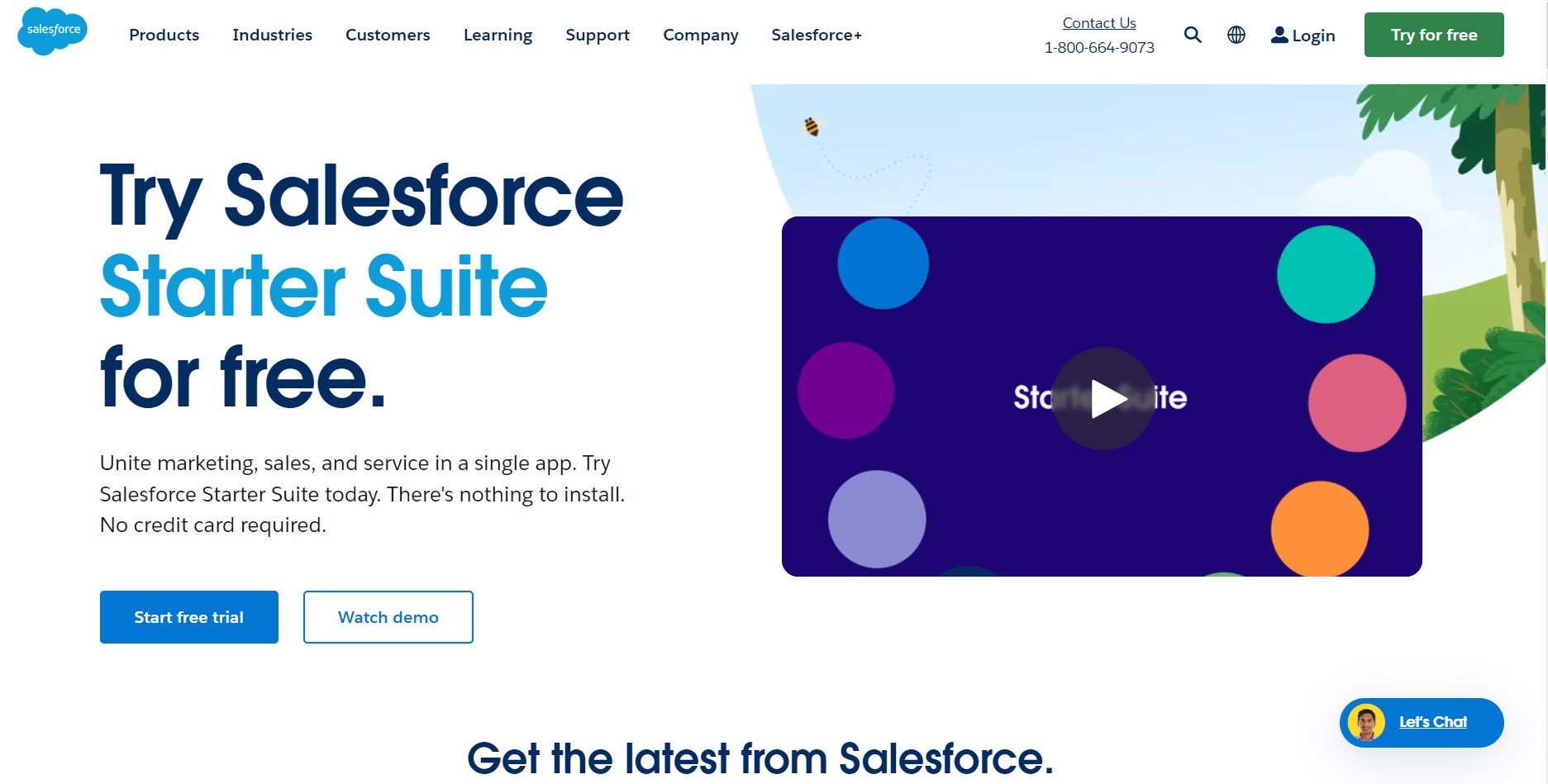
Image via Salesforce
For organizations that wish to unify all the data sources and orchestrate complex business logic to function as the brain of the organization, Salesforce is the best bet.
Salesforce isn’t the CRM solution for companies that are looking for a simple CRM system that works out of the box. It isn’t designed for small to mid-sized teams that intend to store vital information about the customer and manage a sales pipeline. Instead, it’s a powerful tool for larger organizations with complex business needs.
The functionalities of Salesforce within an organization can be much more than just a CRM. It can be a platform for digital marketing, e-commerce, customer service, and even an integration point for third-party apps, AI and ML platforms, business intelligence and analytics, the company website, and many other elements in a corporate technology infrastructure.
Salesforce offers endless possibilities for large-scale enterprises, specifically those with complex needs and ERP systems.
Despite being so powerful, Salesforce might not always be the best investment. There are cases, for example, when Salesforce implementations cost multiple times more than the estimated costs.
Should you go for it?
Salesforce for CRM is a huge investment, and generally, only large-scale businesses can afford it. If you are among these enterprises, you’ll need to consult Salesforce CRM experts who can guide you by analyzing your requirements and needs.
The Salesforce ecosystem offers a CRM and a dedicated marketing automation platform called Pardot. You don’t necessarily need to pay for this software, as Salesforce can be easily integrated with other marketing automation tools like Hubspot and Marketo.
2. HubSpot CRM
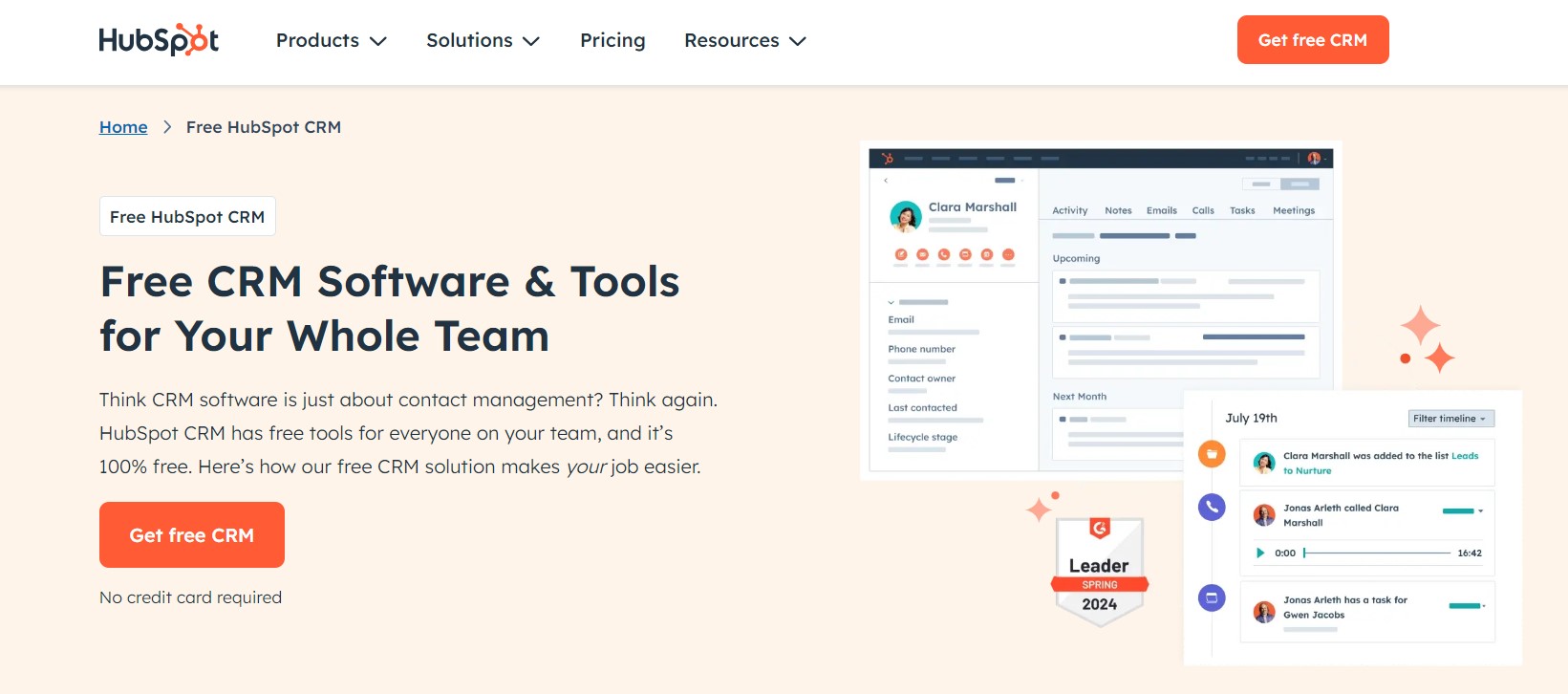
Image via Hubspot
HubSpot is the most popular off-the-shelf CRM choice for businesses across the world. It offers a free plan for businesses that want to try a CRM system before investing in it. This can be particularly helpful for those facing challenges in CRM implementation due to budget constraints.
Of course, the free plan comes with several limitations in terms of the number of contacts you can manage and other marketing functionalities.
At the subscription level, HubSpot CRM is a marketing machine that escalates your sales and marketing performance. It provides you with powerful features, integration options, and business processes that justify its cost.
In terms of user experience, HubSpot is a one-of-a-kind CRM solution provider. It minimizes the complexity of customer data management and marketing automation by delivering super responsive and intuitive user interfaces and experiences.
If you discover you need the pro or enterprise-level features in the future, you can always upgrade your subscription. Hence, HubSpot is highly recommended for teams and businesses that don’t need a CRM tool with enterprise-level interoperability and integration.
You May Also Like:
3. Zoho CRM
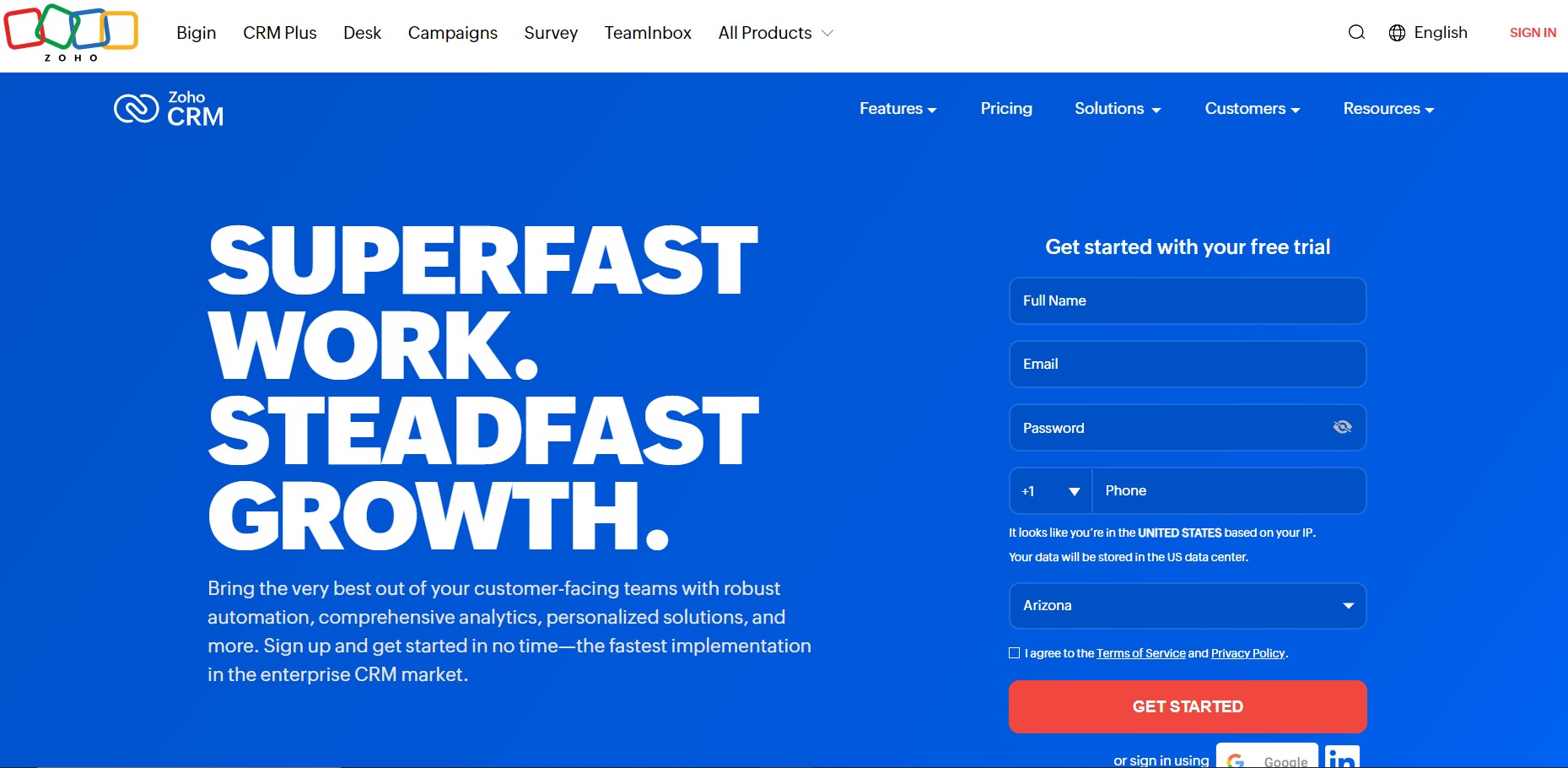
Image via Zoho CRM
Zoho is one of the fastest-growing CRM tools at present. It caters to several scales of businesses with its variety of pricing plans, making it a versatile option for modern businesses looking to improve their customer relationship management.
Zoho CRM pricing plans start at free for 3 users, followed by the paid CRM plan for small businesses (at $20/month/user). It then goes up to CRM Plus for enterprises (at $65/month/user).
The platform’s top subscription plans combine sales, marketing, help desk, and other customer touchpoints to deliver a central place for management and business insights.
On top of the CRM functions, Zoho offers a suite of additional services for finance and custom solutions that allow it to provide holistic solutions for businesses.
Moreover, with its suite of services, Zoho offers a comprehensive reporting feature that includes dozens of pre-made reports and insights. Not only does it facilitate report customization, but it also allows users to collaborate around insights and reports by utilizing the comment section.
4. SharpSpring
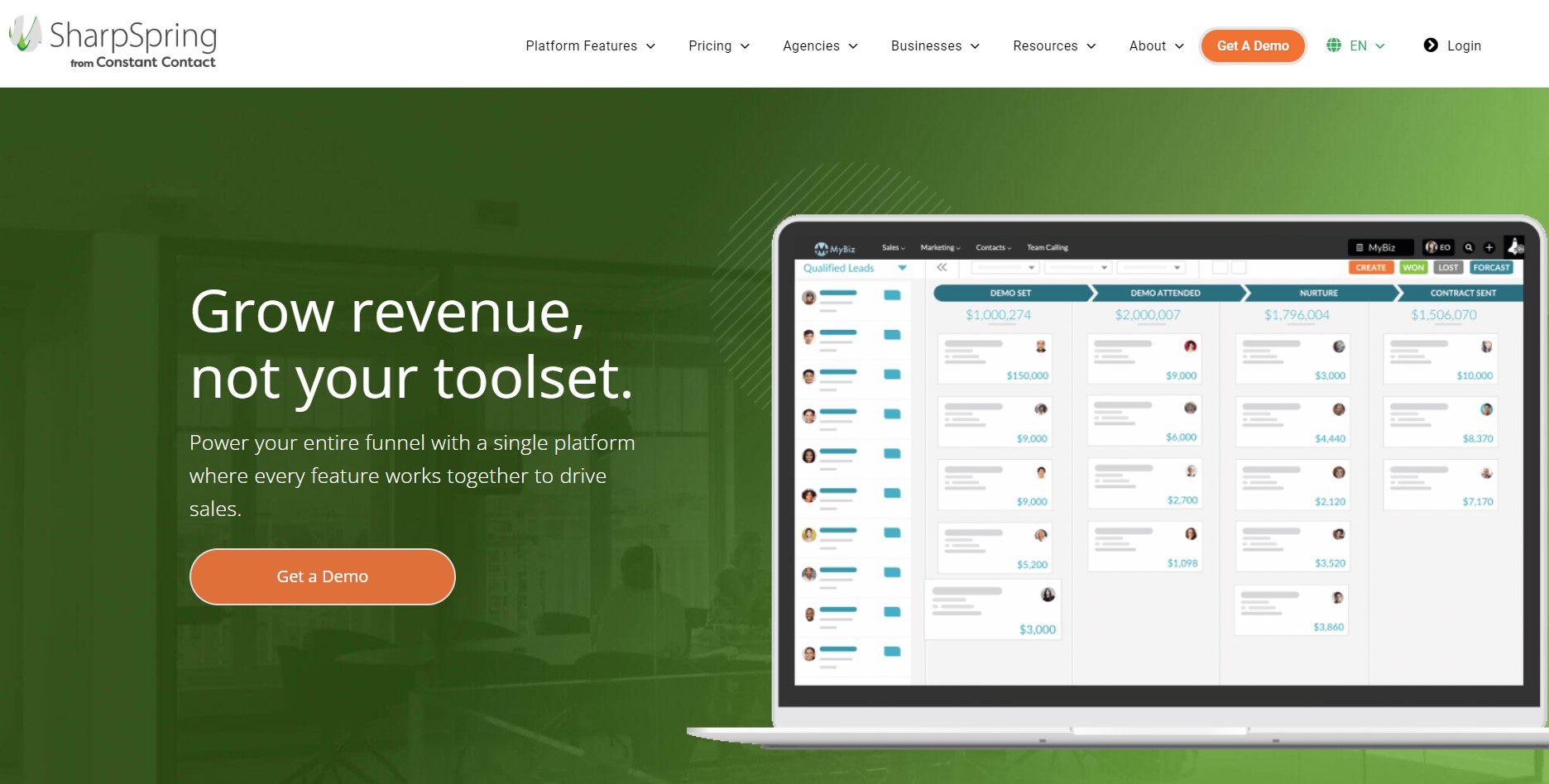
Image via SharpSpring
If you’re looking for a HubSpot-like CRM tool but don’t want to invest that much, SharpSpring is worth having a look at. It can provide you with similar features and functionalities, though it’s not quite as advanced as HubSpot.
Although SharpSpring’s user experience and speed of innovation are way behind HubSpot, it justifies its price point.
The user experience of a CRM tool is of high importance because it influences end-user adoption and productivity. Still, cost remains the most significant factor for small- to midsize-scale businesses.
If you fall into this category, give SharpSpring a try.
You May Also Like:
5. Bitrix24
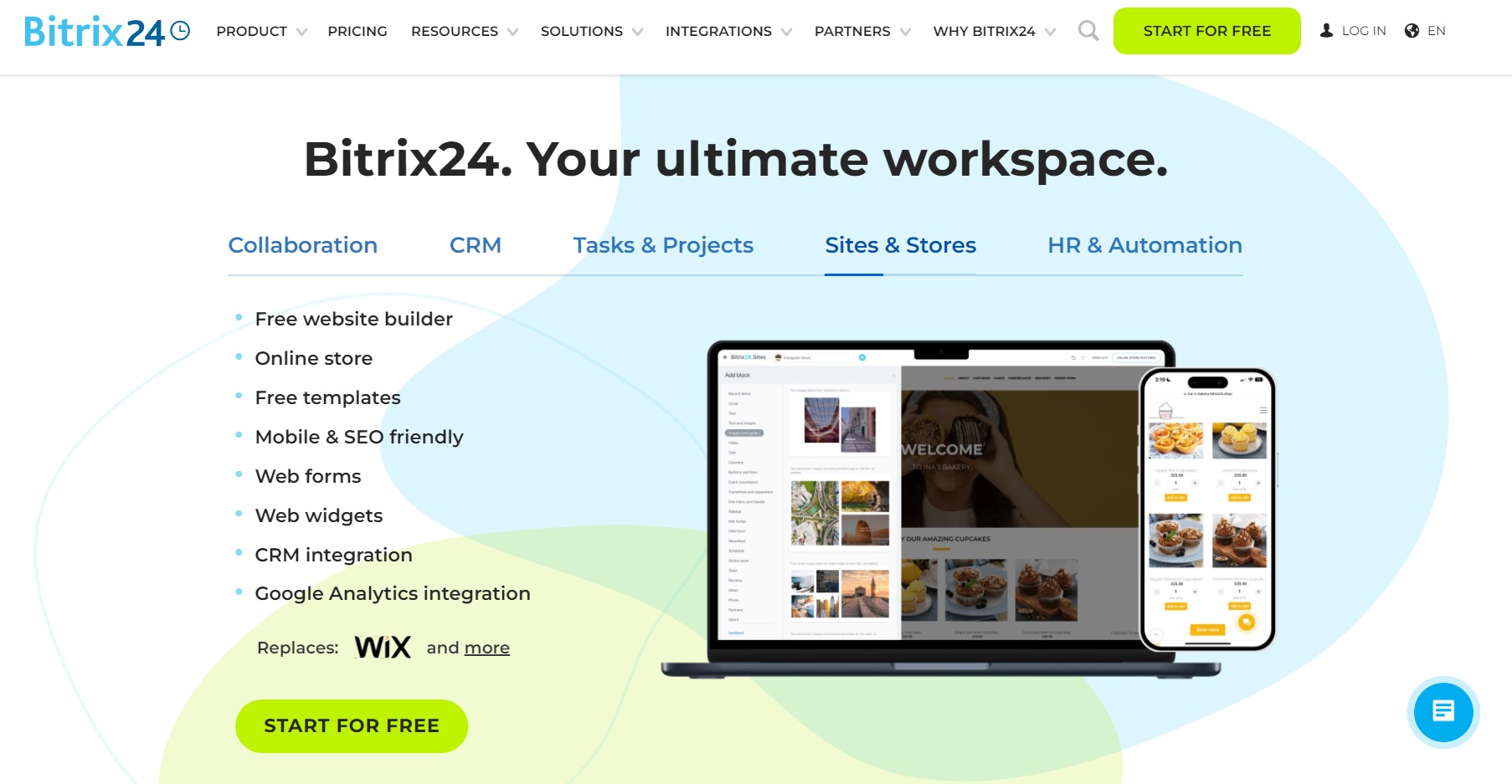
Image via Bitrix24
Remote working seems to be the new normal. Bitrix24 is an excellent Salesforce alternative for many businesses, providing tons of options for staying in touch, collaborating, and sharing information. This CRM system can be particularly useful for businesses with multiple departments that need to work together seamlessly.
The app offers many features, including fully functional CRM, marketing automation, web design capabilities, and CRM project management.
To give you a peek into Bitrix24’s Project management and collaboration functionality, you can create departments or projects and add employees to them. This works as a basis for segmenting teams for workgroups, knowledge sharing, and communication.
In addition to CRM and marketing automation-related services, Bitrix24 offers a suite of business services that range from human resources to communication.
And speaking of communication, Bitrix24 facilitates integration with more than 70 VoIP providers, including Nextiva, RingCentral, and Vonage. You can even rent a number and pay via the tool itself.
6. Pipedrive
If you’re in the market for an easy-to-use CRM tool for your salespeople, Pipedrive is a smart choice. Although the platform offers several functionalities, its primary goal is to help salespeople do their jobs more efficiently, which can lead to improved customer satisfaction and operational efficiency.
Salespeople can email prospects directly from the Pipedrive inbox or contact record. They can even sync their Google or Outlook calendars to manage their meeting availability and create meeting links to share with their contacts.
A very advanced feature that Pipedrive offers is Smart Contact Data, which pulls social profiles or work emails from contacts with a single click. Similar to Bitrix24, Pipedrive also facilitates a calling feature.
There are many other CRM tools, like Oracle and SAP, of course. But the ones listed above are a great starting point as you explore your CRM options.
7. Copper

Image via Copper
Copper is a user-friendly CRM system designed specifically for Google Workspace users. If you use Google’s tools like Gmail and Google Calendar, Copper could be the right CRM solution provider for your business. It automatically captures and organizes your customer data from these tools, saving you time on data entry.
Copper stands out by focusing on relationships rather than deals. This approach can help you build stronger customer relationships over time. This tool offers features like pipeline management, task tracking, and reporting, all with a clean, easy-to-use interface.
For small to medium-sized businesses looking to improve their customer relationship management, Copper provides a straightforward solution. It’s particularly useful if you want to increase sales without spending hours learning a complex system.
With prices starting at $12/user/month, Copper offers a balance of affordability and functionality for growing businesses.
You May Also Like:
FAQs
Q1. What are the most common challenges of CRM?
Following are the most common challenges of CRM implementation in 2025:
- Building a clear CRM implementation strategy
- Bringing in change across departments
- Managing the time and cost associated with CRM implementation
- Scaling your business’s CRM solution
- Convincing top-level management
- Ensuring data security
- Relearning the software programs
- Future-proofing the technology implementation
- Lack of clarity in terms of scope
- Lacking integration with your existing IT infrastructure
- Ensuring data quality
Implementing CRM for the first time can be tricky for many organizations. Most often, neither the sales teams nor the management have experience restructuring the sales process and introducing technology to achieve higher productivity and efficiency. This lack of experience can lead to various challenges in CRM implementation.
Q2. What Are the Benefits of CRM?
CRM software can bring a wealth of benefits to small and large businesses. Following are the top benefits you can achieve by adopting the right CRM for your needs.
- Provide better customer service if you have a CRM system in place.
- When you care for your customers and build good customer relationships, you achieve a high customer retention rate.
- A good CRM helps develop positive relationships with prospects, which can increase sales over time.
- A high retention rate and better customer relations result in increased sales.
- A sound CRM system provides you with data analytics and business insights through which you can plan for the future.
- CRM builds transparency and facilitates collaboration, resulting in sales, marketing, and customer relations teams’ productivity and efficiency.
- An enterprise-level CRM acts as a central database of information.
- Most CRM tools are layered with a marketing automation functionality that improves conversion.
- Data-powered CRM tools can help you forecast more accurate sales figures.
Q3. Custom-built or off-the-shelf: which CRM should I pick?
There is no universal answer to this. Both CRM implementation approaches have their own benefits and challenges. Once again, the right CRM solution depends on your specific business needs and the challenges of CRM you’re facing.
Off-the-shelf CRM tools are popular with small to mid-sized businesses that don’t have a dedicated information technology department.
Custom CRM development is only for those businesses that are growing too fast and need to quickly respond to changes in the market and competitors’ strategies. Most enterprise-level companies go for custom-built CRMs.
Q4. What are the pros and cons of custom-built CRM?
Pros:
- Tailor-made for your business processes.
- Provides total control over the selection of technologies, integrations, and features.
- Offers maximum data security.
- Ensures easy user adoption.
- No need to pay user licensing fees or subscription renewal charges on a recurring basis.
- Provides maximum performance enhancement.
Cons:
- Building a custom CRM tool is expensive.
- You either need to hire technology resources to develop the CRM tool in-house or pick a CRM development partner among the pool of software outsourcing companies.
- The development and implementation of custom CRM software takes a lot of time.
Q5. What are the pros and cons of off-the-shelf CRM tools?
Pros:
- Offers advanced CRM technologies and tools off-the-shelf.
- The cost of an off-the-shelf CRM is meager compared to a custom-built CRM.
- Customers don’t have to conduct training programs separately for their employees.
- Setting up an off-the-shelf CRM tool is quick and easy.
- You can test an off-the-shelf CRM tool before making a commitment.
- Off-the-shelf CRM tools are easy to upgrade, as you can simply subscribe to or upgrade to the service to begin using them.
- Off-the-shelf CRM tools provide the quickest ROI.
Cons:
- You can’t expect a competitive advantage with off-the-shelf CRM tools.
- Not all off-the-shelf CRM tools have the features you may want.
- The long-term cost of off-the-shelf CRM tools is higher than that of custom-built CRMs.
- Off-the-shelf CRM tools aren’t built according to your specific business needs and processes.
- As you might have to change the way you manage customer interactions, you will observe employer downtime and a steep learning curve.
- There is a risk to data security as you will be trusting a third-party software vendor with your customer data.
- Not every off-the-shelf CRM tool can integrate with your existing technology infrastructure.
Q6. What are the top CRM tools of 2025?
Following are the top CRM tools of 2025 based on different use cases and organization levels:
- Salesforce
- Hubspot CRM
- Zoho CRM
- SharpSpring
- Bitrix24
- Pipedrive
- Copper
Q7. What are the challenges of CRM adoption?
The main challenges of CRM adoption are usually triggered by employees and can result in implementation failure. Following are the most common challenges of CRM adoption that you should eliminate before they become significant problems.
- Not providing adequate training to workers who will use it.
- Employees losing confidence in the product as they aren’t familiar with the benefits of adopting CRM.
- Less focus on the actual user: Companies make the mistake of building CRM tools centered around the needs of sales managers. However, they should focus more on the sales, marketing, and customer relations team members to craft the CRM solution according to their needs.
- CRM adoption not being the top priority: Migrating to a new setup and adopting new practices can be challenging for many employees unless the organization prioritizes seamless CRM implementation.
- Not getting adequate space to learn: If you don’t provide your employees with adequate time to learn the CRM system, they won’t adapt to it.
Q8. How can I pick the right off-the-shelf CRM tool for my company?
Selecting the right CRM solution for your company can be a challenge. There are several factors you need to consider before picking an off-the-shelf CRM tool.
Here are some questions to help guide your decision-making process:
- Can it integrate with your existing marketing technology infrastructure?
- Does it have an email integration feature for your email service provider?
- Does it offer document management features that enable team collaboration?
- Does it allow you to create and send quotes or proposals to customers?
- How does it manage the customer pipeline?
- Does it offer workflow automation for repetitive tasks?
- Does its contact management functionality make sense to you?
- Does it offer an interaction tracking feature that allows all the necessary parties to collaborate?
- Can it illustrate your customer funnel and drive valuable insights?
- Do you need advanced analytics functionality? If yes, how well does your CRM cater to your analytics needs?
- Does the CRM tool offer sales forecasting and projection features based on historical data and current trends?
Q9. What are the CRM user adoption best practices?
Here is how you can improve CRM adoption among your workers and overcome the common challenges of CRM implementation:
- Convey benefits related to CRM tools, like how they will improve their productivity and help them obtain and serve more customers.
- Gather feedback from future users before implementing your CRM tool. Understand what the most crucial CRM features for them are to ensure employees understand the system’s value.
- Make your workers a part of your CRM journey.
- Appoint assistance that will guide employees through CRM adoption.
- Make CRM use mandatory for everyone in the customer relations ecosystem. It should be the only repository for your organization.
- Make CRM adoption fun by introducing reward programs.
Q10. What is the cost of custom-built CRM software?
Typically, CRM solutions like Salesforce can cost around $250–7,500 for a 10-15-user team monthly.
Time to Implement Your CRM Without the Challenges
If you’ve made it this far, then you’re surely in need of a CRM solution. The only question that remains is which CRM you’ll choose.
Depending on the type, the challenges of CRM will differ. Make sure you identify them beforehand and work towards mitigating the risk of implementation failure.
If you have any questions, leave them in the comment box. We’re happy to help!











